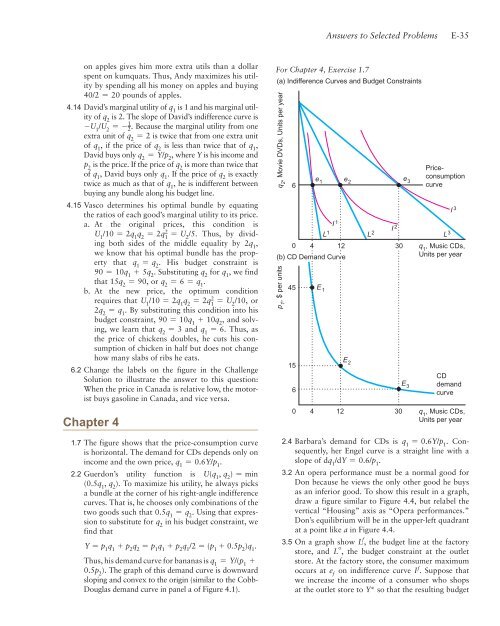Answers to Selected Problems
Answers to Selected Problems
Answers to Selected Problems
Create successful ePaper yourself
Turn your PDF publications into a flip-book with our unique Google optimized e-Paper software.
on apples gives him more extra utils than a dollar<br />
spent on kumquats. Thus, Andy maximizes his utility<br />
by spending all his money on apples and buying<br />
40/2 = 20 pounds of apples.<br />
4.14 David’s marginal utility of q 1 is 1 and his marginal util-<br />
ity of q2 is 2. The slope of David’s indifference curve is<br />
-U1 /U2 = - 1<br />
2 . Because the marginal utility from one<br />
extra unit of q2 = 2 is twice that from one extra unit<br />
of q1 , if the price of q2 is less than twice that of q1 ,<br />
David buys only q2 = Y/p2 , where Y is his income and<br />
p2 is the price. If the price of q2 is more than twice that<br />
of q1 , David buys only q1 . If the price of q2 is exactly<br />
twice as much as that of q1 , he is indifferent between<br />
buying any bundle along his budget line.<br />
4.15 Vasco determines his optimal bundle by equating<br />
the ratios of each good’s marginal utility <strong>to</strong> its price.<br />
a. At the original prices, this condition is<br />
U1 /10 = 2q1q2 = 2q2 1 = U2 /5. Thus, by dividing<br />
both sides of the middle equality by 2q1 ,<br />
we know that his optimal bundle has the property<br />
that q1 = q2 . His budget constraint is<br />
90 = 10q1 + 5q2 . Substituting q2 for q1 , we find<br />
that 15q2 = 90, or q2 = 6 = q1 .<br />
b. At the new price, the optimum condition<br />
requires that U1 /10 = 2q1q2 = 2q2 1 = U2 /10, or<br />
2q2 = q1 . By substituting this condition in<strong>to</strong> his<br />
budget constraint, 90 = 10q1 + 10q2 , and solving,<br />
we learn that q2 = 3 and q1 = 6. Thus, as<br />
the price of chickens doubles, he cuts his consumption<br />
of chicken in half but does not change<br />
how many slabs of ribs he eats.<br />
6.2 Change the labels on the figure in the Challenge<br />
Solution <strong>to</strong> illustrate the answer <strong>to</strong> this question:<br />
When the price in Canada is relative low, the mo<strong>to</strong>rist<br />
buys gasoline in Canada, and vice versa.<br />
Chapter 4<br />
1.7 The figure shows that the price-consumption curve<br />
is horizontal. The demand for CDs depends only on<br />
income and the own price, q 1 = 0.6Y/p 1 .<br />
2.2 Guerdon’s utility function is U(q 1 , q 2 ) = min<br />
(0.5q 1 , q 2 ). To maximize his utility, he always picks<br />
a bundle at the corner of his right-angle indifference<br />
curves. That is, he chooses only combinations of the<br />
two goods such that 0.5q 1 = q 2 . Using that expression<br />
<strong>to</strong> substitute for q 2 in his budget constraint, we<br />
find that<br />
Y = p 1 q 1 + p 2 q 2 = p 1 q 1 + p 2 q 1 /2 = (p 1 + 0.5p 2 )q 1 .<br />
Thus, his demand curve for bananas is q 1 = Y/(p 1 +<br />
0.5p 2 ). The graph of this demand curve is downward<br />
sloping and convex <strong>to</strong> the origin (similar <strong>to</strong> the Cobb-<br />
Douglas demand curve in panel a of Figure 4.1).<br />
<strong>Answers</strong> <strong>to</strong> <strong>Selected</strong> <strong>Problems</strong><br />
For Chapter 4, Exercise 1.7<br />
(a) Indifference Curves and Budget Constraints<br />
q 2 , Movie DVDs, Units per year<br />
6<br />
45<br />
15<br />
6<br />
E-35<br />
L<br />
0<br />
1<br />
L2 L3 I 1<br />
I 2<br />
4 12<br />
(b) CD Demand Curve<br />
30 q1 , Music CDs,<br />
Units per year<br />
p 1 , $ per units<br />
e 1<br />
E 1<br />
e 2<br />
E 2<br />
0 4 12 30<br />
2.4 Barbara’s demand for CDs is q1 = 0.6Y/p1 . Consequently,<br />
her Engel curve is a straight line with a<br />
slope of dq1 /dY = 0.6/p1 .<br />
3.2 An opera performance must be a normal good for<br />
Don because he views the only other good he buys<br />
as an inferior good. To show this result in a graph,<br />
draw a figure similar <strong>to</strong> Figure 4.4, but relabel the<br />
vertical “Housing” axis as “Opera performances.”<br />
Don’s equilibrium will be in the upper-left quadrant<br />
at a point like a in Figure 4.4.<br />
3.5 On a graph show L f , the budget line at the fac<strong>to</strong>ry<br />
s<strong>to</strong>re, and L o , the budget constraint at the outlet<br />
s<strong>to</strong>re. At the fac<strong>to</strong>ry s<strong>to</strong>re, the consumer maximum<br />
occurs at ef on indifference curve If . Suppose that<br />
we increase the income of a consumer who shops<br />
at the outlet s<strong>to</strong>re <strong>to</strong> Y* so that the resulting budget<br />
e 3<br />
E 3<br />
Priceconsumption<br />
curve<br />
I 3<br />
CD<br />
demand<br />
curve<br />
q 1 , Music CDs,<br />
Units per year
















